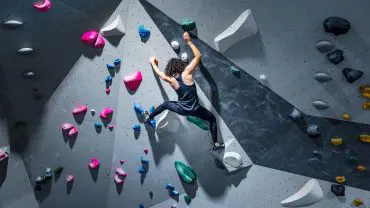The words ‘jiu jitsu’ are most commonly translated as ‘gentle art’, not because the form of self-defence is gentle on the attacker, far from it! Rather, jiu jitsu techniques don’t require much strength by the practitioner applying them.
Here, we’ll answer the question ‘what is Brazilian jiu jitsu’ and we’ll even let you know what to wear to jiu jitsu.
What is Brazilian Jiu Jitsu - A Short History

Practicing Brazilian Jujutsu (Photo: Kilito Chan via Getty Images)
In the early twentieth century, Mitsuyo Maeda, a protégé of judo founder Kanō Jigorō embarked on a global tour to promote and teach Japanese martial arts, especially jiu jitsu and judo. He went to the UK, Spain, USA, Cuba and Mexico and he wound up in Brazil in 1915. Three of his first class of students were brothers Carlos and Helio Gracie and Luiz França and even today, the Gracie family are often known as the ‘First Family of Martial Arts’ in Brazil.
As with the development of all sports over the years, answering ‘what is Brazilian jiu jitsu’ has become more complex. However, similar to Japanese jiu jitsu, it is about mastering the skill of reducing an opponent to the ground by overpowering him or her using their own strength against them. As jiu jitsu in Brazil has grown, so the skills, techniques and tactics have become specific to the Brazilian version, but they are largely based on the traditional Japanese methods.
The Story of Japanese Jiu Jitsu

Jiu Jitsu- the Japanese system of unarmed combat and physical training (Photo: HollenderX2 via Getty Images)
When considering what is jiu jitsu, the first documented history of this martial art comes from the eighth century Japanese Nara period. It was during this time that combined elements of Sumo and other martial arts allowed medieval Samurai warriors to engage in close-quarters combat if they found themselves unarmed or dismounted from their horses.
Fundamentally it taught them to counter attacks by throwing, demobilising, sweeping, choke-holds and locking joints, since all-out attack was futile against an opponent in a suit of armour.
Like many martial arts, there is no single answer to the question ‘what is jiu jitsu.’ The art form evolved over the centuries into different schools and styles as each master created new techniques and characteristics. In fact even today, the masters are inventing new and improved tactics and techniques.
What is Jiu Jitsu?

Jujitsu skills in practice (Photo: South_agency via Getty Images)
The martial art of jiu jitsu – Brazilian or otherwise – is about overcoming an opponent by using their own force against them.
It’s considered to be non-violent and the throwing, choke-holds, demobilisation, sweeping and joint manipulation rely on an innate understanding of the principles of leverage, balance, speed, pressure points, angles of attack and an acute sense of timing. In addition, a knowledge of the weak and vulnerable points in the human body is important to master the art.
At its upper levels, jiu jitsu is a powerful and devastating form of self-defence which allows for an appropriate response to any and all levels of violent confrontation.
What Order are the Belts in Jiu Jitsu?

Jiu Jitsu belts and uniform (Photo: PeopleImages via Getty Images)
At school, at work, in music or in sports, being recognised for dedication, commitment, talent and hard work is incredibly rewarding. Grading in jiu jitsu is based on two degrees – the kyū degrees which run up to black belt level and the dan degrees which are achieved once you are at black belt level.
Some jiu jitsu schools start with a red belt before white belt level to mark the beginners, and certain schools and clubs may differ slightly – some add a purple belt for example – but generally speaking, this is the order –
Kyū Degrees
- White belt | 6th kyū | rokkyu
- Yellow belt | 5th kyū | gokyu
- Orange belt | 4th kyū | yonku
- Green belt | 3rd kyū | sankyu
- Blue belt | 2nd kyū | nikyu
- Brown belt | 1st kyū | ikkyu
Dan Degrees
- Black belt, 1 white stripe | 1st dan | shodan
- Black belt, 2 white stripes | 2nd dan | nidan
- Black belt, 3 white stripes | 3rd dan | sandan
- Black belt, 4 white stripes | 4th dan | yodan
- Black belt, 3 stripes (red-white-red) | 5th dan | godan
- Black belt, red-white chequered | 6th dan | rokudan
- Black belt, red-white chequered | 7th dan | shichidan
- Black belt, red-white chequered | 8th dan | hachidan
- Red belt | 9th dan | kudan
- Red belt | 10th dan | judan
- Red belt | 11th dan | juichidan
- Wide white belt | 12th dan | junidan
As well as the belts, what to wear to jiu-jitsu is also very important. Traditionally, jiu jitsu practitioners wear a uniform known as a ‘keikogi’ which is a heavy cotton jacket and trousers with the appropriate colour belt. In Japanese ‘keiko’ means ‘practice’ and ‘gi’ means ‘dress’ or ‘clothes’ and it was developed by Kanō Jigorō.
Jiu jitsu has sometimes been described as ‘human chess,’ in that it is as much about positioning, technique, skill and strategy as it is about power and strength.
So now you know the answers to the questions ‘what is jiu jitsu’ and ‘what is Brazilian jiu jitsu’, it’s off to the dojo with your keikogi on to learn to become a jiu jitsuka.











